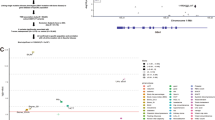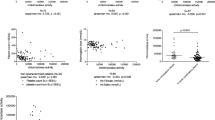Abstract
Gaucher disease (GD) is one of the most prevalent lysosomal storage disorders and the disorder that has the greatest immune system involvement. Pathologic lipid accumulation in macrophages accounts for a small amount of the additional tissue mass in the liver and spleen. The additional increase may be related to an inflammatory response because Gaucher cells secrete inflammatory mediators. Osteopontin (OPN) is a protein identified in cancer cells and in bone cells that is produced by several types of immune cells including T-cells and macrophages. We report here elevated OPN levels in the plasma of type 1 GD patients and its sensitive response to enzyme replacement therapy. The mean OPN value of GD patients receiving ERT was similar to the values of controls and patients with other lysosomal disorders. When comparing untreated and treated GD patients, the p value was <0.001. In GD, OPN appears to be more sensitive to ERT than chitotriosidase and can be used during the follow-up of patients who are chitotriosidase deficient. Additional extended studies are required to relate variations in the OPN levels to clinical findings and response to therapy in GD patients.




Similar content being viewed by others
References
Meikle PJ, Hopwood JJ (2003) Lysosomal storage disorders: emerging therapeutic options require early diagnosis. Eur J Pediatr 162(Suppl 1):S34–S37
Mistry PK, Cappellini MD, Lukina E, Ozsan H, Mach Pascual S, Rosenbaum H et al (2011) A reappraisal of Gaucher disease-diagnosis and disease management algorithms. Am J Hematol 86(1):110–115
Beutler E (2006) Gaucher disease: multiple lessons from a single gene disorder. Acta Paediatr Suppl 95(451):103–109
Jmoudiak M, Futerman AH (2005) Gaucher disease: pathological mechanisms and modern management. Br J Haematol 129(2):178–188
Hughes DA, Pastores GM (2010) The pathophysiology of GD - current understanding and rationale for existing and emerging therapeutic approaches. Wien Med Wochenschr 160(23–24):594–599
Boven LA, van Meurs M, Boot RG, Mehta A, Boon L, Aerts JM et al (2004) Gaucher cells demonstrate a distinct macrophage phenotype and resemble alternatively activated macrophages. Am J Clin Pathol 122(3):359–369
Ron I, Horowitz M (2005) ER retention and degradation as the molecular basis underlying Gaucher disease heterogeneity. Hum Mol Genet 14(16):2387–2398
Pelled D, Trajkovic-Bodennec S, Lloyd-Evans E, Sidransky E, Schiffmann R, Futerman AH (2005) Enhanced calcium release in the acute neuronopathic form of Gaucher disease. Neurobiol Dis 18(1):83–88
Deganuto M, Pittis MG, Pines A, Dominissini S, Kelley MR, Garcia R et al (2007) Altered intracellular redox status in Gaucher disease fibroblasts and impairment of adaptive response against oxidative stress. J Cell Physiol 212(1):223–235
Sun Y, Grabowski GA (2010) Impaired autophagosomes and lysosomes in neuronopathic Gaucher disease. Autophagy 6(5):648–649
Cox TM (2001) Gaucher disease: understanding the molecular pathogenesis of sphingolipidoses. J Inherit Metab Dis 24(Suppl 2):106–121, discussion 87-8
Moran MT, Schofield JP, Hayman AR, Shi GP, Young E, Cox TM (2000) Pathologic gene expression in Gaucher disease: up-regulation of cysteine proteinases including osteoclastic cathepsin K. Blood 96(5):1969–1978
Hollak CE, Evers L, Aerts JM, van Oers MH (1997) Elevated levels of M-CSF, sCD14 and IL8 in type 1 Gaucher disease. Blood Cells Mol Dis 23(2):201–212
Pavlova EV, Deegan PB, Tindall J, McFarlane I, Mehta A, Hughes D et al (2011) Potential biomarkers of osteonecrosis in Gaucher disease. Blood Cells Mol Dis 46(1):27–33
Aerts JM, Hollak CE (1997) Plasma and metabolic abnormalities in Gaucher’s disease. Bailliere’s Clin Haematol 10(4):691–709
Hollak CE, van Weely S, van Oers MH, Aerts JM (1994) Marked elevation of plasma chitotriosidase activity. A novel hallmark of Gaucher disease. J Clin Investig 93(3):1288–1292
Boot RG, Verhoek M, de Fost M, Hollak CE, Maas M, Bleijlevens B et al (2004) Marked elevation of the chemokine CCL18/PARC in Gaucher disease: a novel surrogate marker for assessing therapeutic intervention. Blood 103(1):33–39
Dekker N, van Dussen L, Hollak CE, Overkleeft H, Scheij S, Ghauharali K et al (2011) Elevated plasma glucosylsphingosine in Gaucher disease: relation to phenotype, storage cell markers, and therapeutic response. Blood 118(16):e118–e127
Rolfs A, Giese AK, Grittner U, Mascher D, Elstein D, Zimran A et al (2013) Glucosylsphingosine is a highly sensitive and specific biomarker for primary diagnostic and follow-up monitoring in Gaucher disease in a non-Jewish, Caucasian cohort of Gaucher disease patients. PLoS One 8(11):e79732
Senger DR, Perruzzi CA, Papadopoulos A, Tenen DG (1989) Purification of a human milk protein closely similar to tumor-secreted phosphoproteins and osteopontin. Biochim Biophys Acta 996(1–2):43–48
Oldberg A, Franzen A, Heinegard D (1986) Cloning and sequence analysis of rat bone sialoprotein (osteopontin) cDNA reveals an Arg-Gly-Asp cell-binding sequence. Proc Natl Acad Sci U S A 83(23):8819–8823
Weber GF, Cantor H (1996) The immunology of Eta-1/osteopontin. Cytokine Growth Factor Rev 7(3):241–248
Rittling SR, Chambers AF (2004) Role of osteopontin in tumour progression. Br J Cancer 90(10):1877–1881
Ramaiah SK, Rittling S (2008) Pathophysiological role of osteopontin in hepatic inflammation, toxicity, and cancer. Toxicol Sci : Off J Soc Toxicol 103(1):4–13
Atkins K, Berry JE, Zhang WZ, Harris JF, Chambers AF, Simpson RU et al (1998) Coordinate expression of OPN and associated receptors during monocyte/macrophage differentiation of HL-60 cells. J Cell Physiol 175(2):229–237
Konno S, Eckman JA, Plunkett B, Li X, Berman JS, Schroeder J et al (2006) Interleukin-10 and Th2 cytokines differentially regulate osteopontin expression in human monocytes and dendritic cells. J Interf Cytokine Res : Off J Int Soc Interferon and Cytokine Res 26(8):562–567
Li X, O’Regan AW, Berman JS (2003) IFN-gamma induction of osteopontin expression in human monocytoid cells. J Interf Cytokine Res : Off J Int Soc Interferon and Cytokine Res 23(5):259–265
Rollo EE, Denhardt DT (1996) Differential effects of osteopontin on the cytotoxic activity of macrophages from young and old mice. Immunology 88(4):642–647
O’Regan AW, Hayden JM, Berman JS (2000) Osteopontin augments CD3-mediated interferon-gamma and CD40 ligand expression by T cells, which results in IL-12 production from peripheral blood mononuclear cells. J Leukoc Biol 68(4):495–502
Zheng W, Li R, Pan H, He D, Xu R, Guo TB et al (2009) Role of osteopontin in induction of monocyte chemoattractant protein 1 and macrophage inflammatory protein 1beta through the NF-kappaB and MAPK pathways in rheumatoid arthritis. Arthritis Rheum 60(7):1957–1965
Nystrom T, Duner P, Hultgardh-Nilsson A (2007) A constitutive endogenous osteopontin production is important for macrophage function and differentiation. Exp Cell Res 313(6):1149–1160
Giachelli CM, Lombardi D, Johnson RJ, Murry CE, Almeida M (1998) Evidence for a role of osteopontin in macrophage infiltration in response to pathological stimuli in vivo. Am J Pathol 152(2):353–358
Bourassa B, Monaghan S, Rittling SR (2004) Impaired anti-tumor cytotoxicity of macrophages from osteopontin-deficient mice. Cell Immunol 227(1):1–11
Pedraza CE, Nikolcheva LG, Kaartinen MT, Barralet JE, McKee MD (2008) Osteopontin functions as an opsonin and facilitates phagocytosis by macrophages of hydroxyapatite-coated microspheres: implications for bone wound healing. Bone 43(4):708–716
Vedder AC, Cox-Brinkman J, Hollak CE, Linthorst GE, Groener JE, Helmond MT et al (2006) Plasma chitotriosidase in male Fabry patients: a marker for monitoring lipid-laden macrophages and their correction by enzyme replacement therapy. Mol Genet Metab 89(3):239–244
Dornelles AD, de Oliveira Netto CB, Vairo F, de Mari JF, Tirelli KM, Schwartz IV (2014) Breastfeeding in Gaucher disease: is enzyme replacement therapy safe? Clin Ther 36(6):990–991
Castaneda JA, Lim MJ, Cooper JD, Pearce DA (2008) Immune system irregularities in lysosomal storage disorders. Acta Neuropathol 115(2):159–174
Rittling SR (2011) Osteopontin in macrophage function. Expert Rev Mol Med 13:e15
Raghupathy R, Makhseed M, Azizieh F, Omu A, Gupta M, Farhat R (2000) Cytokine production by maternal lymphocytes during normal human pregnancy and in unexplained recurrent spontaneous abortion. Hum Reprod 15(3):713–718
Choi ST, Kim JH, Kang EJ, Lee SW, Park MC, Park YB et al (2008) Osteopontin might be involved in bone remodelling rather than in inflammation in ankylosing spondylitis. Rheumatology (Oxford) 47(12):1775–1779
Yoshino M, Watanabe Y, Tokunaga Y, Harada E, Fujii C, Numata S et al (2007) Roles of specific cytokines in bone remodeling and hematopoiesis in Gaucher disease. Pediatr Int : Off J Jpn Pediatr Soc 49(6):959–965
Wang KX, Denhardt DT (2008) Osteopontin: role in immune regulation and stress responses. Cytokine Growth Factor Rev 19(5–6):333–345
Furger KA, Menon RK, Tuck AB, Bramwell VH, Chambers AF (2001) The functional and clinical roles of osteopontin in cancer and metastasis. Curr Mol Med 1(5):621–632
Rodrigues LR, Teixeira JA, Schmitt FL, Paulsson M, Lindmark-Mansson H (2007) The role of osteopontin in tumor progression and metastasis in breast cancer. Cancer Epidemiol Biomark Prev: a publication of the American Association for Cancer Research, cosponsored by the American Society of Preventive Oncology 16(6):1087–1097
Caers J, Gunthert U, De Raeve H, Van Valckenborgh E, Menu E, Van Riet I et al (2006) The involvement of osteopontin and its receptors in multiple myeloma cell survival, migration and invasion in the murine 5T33MM model. Br J Haematol 132(4):469–477
Maetzler W, Berg D, Schalamberidze N, Melms A, Schott K, Mueller JC et al (2007) Osteopontin is elevated in Parkinson’s disease and its absence leads to reduced neurodegeneration in the MPTP model. Neurobiol Dis 25(3):473–482
Maetzler W, Michelis J, Tomiuk J, Melms A, Becker C, Gasser T et al (2009) A single-nucleotide polymorphism of the osteopontin gene may contribute to a susceptibility to Lewy body disease. J Neural Transm 116(5):599–605
Sun Y, Yin XS, Guo H, Han RK, He RD, Chi LJ (2013) Elevated osteopontin levels in mild cognitive impairment and Alzheimer’s disease. Mediat Inflamm 2013:615745
Siebert M, Sidransky E, Westbroek W (2014) Glucocerebrosidase is shaking up the synucleinopathies. Brain 137(Pt 5):1304–1322
Ribner A, Altarescu G, Zimran A, Elstein D (2011) Osteopontin polymorphic susceptibility factor for Parkinson’s disease among patients with Gaucher disease. Mov Disord 26(7):1341–1343
Acknowledgments
We would like to thank Prof. Roberto Giugliani for his help with the patient samples and discussions; Patricia Koehler dos Santos and André Costa for their help with the analysis; Bianca Heineck for the CHIT1 molecular analysis; Pharm Maira Burin, Prof Ursula Matte, Prof. Guilherme Baldo, and Prof. Patricia Ashton-Prolla for their valuable comments on the paper.
Conflicts of interest
The authors have no conflict of interest to declare.
Details of funding
This study was supported by grants from FIPE-HCPA, the Brazilian Coordination of Improvement of Higher Education Personnel (CAPES), Programa de Apoio a Núcleos de Excelência (PRONEX) of the Conselho Nacional de Desenvolvimento Científico e Tecnológico (CNPq) and unrestricted research grants from Shire.
Authors’ contribution
F. Vairo and I. Schwartz designed and performed the research, analyzed the data, and wrote the paper. F. Sperb-Ludwig, M. Wilke, K. Michellin-Tirelli, C. Netto, and E.C. Neto performed the research and analyzed the data. M. Wilke performed the research and analyzed the data. K. Michellin-Tirelli performed the research and analyzed the data.
Author information
Authors and Affiliations
Corresponding author
Rights and permissions
About this article
Cite this article
Vairo, F., Sperb-Ludwig, F., Wilke, M. et al. Osteopontin: a potential biomarker of Gaucher disease. Ann Hematol 94, 1119–1125 (2015). https://doi.org/10.1007/s00277-015-2354-7
Received:
Accepted:
Published:
Issue Date:
DOI: https://doi.org/10.1007/s00277-015-2354-7




